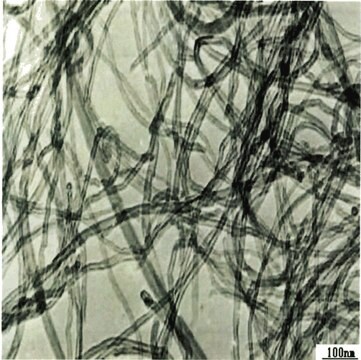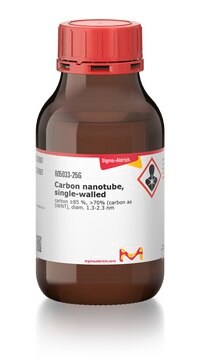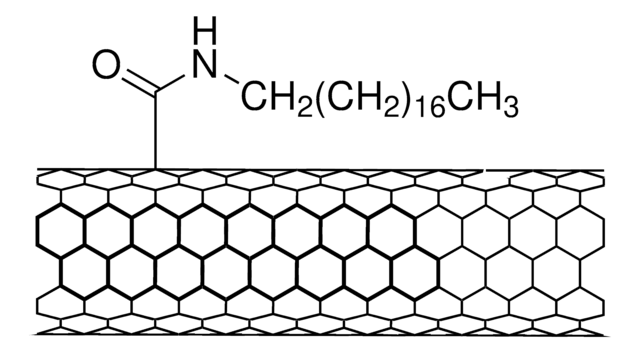Wichtige Dokumente
755125
Carbon nanotube, multi-walled
carboxylic acid functionalized,>90% carbon basis, D × L 9.5 nm × 1.5 μm
Synonym(e):
Carbon nanotube, multi-walled, carboxylic acid functionalized
About This Item
Empfohlene Produkte
Produktbezeichnung
Kohlenstoff-Nanoröhrchen, mehrwandig, Carboxylsäure-funktionalisiert, thin, extent of labeling: >8% carboxylic acid functionalized, avg. diam. × L 9.5 nm × 1.5 μm
Beschreibung
carboxylic acid functionalized
Qualitätsniveau
Assay
>80% carbon basis
Form
powder
Grünere Alternativprodukt-Eigenschaften
Design for Energy Efficiency
Learn more about the Principles of Green Chemistry.
sustainability
Greener Alternative Product
Kennzeichnungsgrad
>8% carboxylic acid functionalized
Mittlerer Durchm. × L
9.5 nm × 1.5 μm
Funktionelle Gruppe
carboxylic acid
Grünere Alternativprodukt-Kategorie
, Enabling
Allgemeine Beschreibung
Anwendung
Deposition (CCVD) process. Applications include Electronics; 1 Sensors; 2 Composites; Energy Storage and Study of Life Science systems.3
Angaben zur Herstellung
Rechtliche Hinweise
Lagerklassenschlüssel
13 - Non Combustible Solids
WGK
WGK 3
Flammpunkt (°F)
Not applicable
Flammpunkt (°C)
Not applicable
Hier finden Sie alle aktuellen Versionen:
Besitzen Sie dieses Produkt bereits?
In der Dokumentenbibliothek finden Sie die Dokumentation zu den Produkten, die Sie kürzlich erworben haben.
Kunden haben sich ebenfalls angesehen
Artikel
Boron nitride nanotubes (BNNT) are close structural analogs of carbon nanotubes (CNT), which are high aspect ratio nanotubular material, where carbon atoms are alternately substituted by nitrogen and boron atoms.
Professor Rivnay (Northwestern University, USA) discusses using organic mixed conductors as an alternative to efficiently bridge the ionic world of biology with contemporary microelectronics.
Carbon nanotubes (CNTs) have received much attention since their discovery in 1991 by Sumio lijima1 due to their excellent mechanical, electrical, and optical properties.
A nanocomposite is typically defined as a mixture between a host material (e.g., polymer matrix) and nanofillers with at least one dimension of less than 100 nm.
Unser Team von Wissenschaftlern verfügt über Erfahrung in allen Forschungsbereichen einschließlich Life Science, Materialwissenschaften, chemischer Synthese, Chromatographie, Analytik und vielen mehr..
Setzen Sie sich mit dem technischen Dienst in Verbindung.






